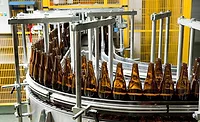Conveyors make accommodations to protect products
Keeping product flowing to boost efficiency.
Just as zone defense is used in basketball as a means to defend specific zones of the court and ultimately protect the goal, zone defense in conveyors also works to protect a goal — but this time the goal is a product or package.
Accumulation zones can pose a potential threat to packages on a conveyor, particularly lightweight containers without much packaging protection, notes Bryan Boyce, product manager of conveyor products for Intelligrated, Mason, Ohio. “They’ll bounce like a basketball when you run them into each other,” he says. In using zone control, a programmable logic controller (PLC) can automatically reduce the speed of the conveyors as they go into accumulation mode so that the cases will match up to each other without impact and damage, he says.
For such scenarios, Intelligrated offers its AccuGlide conveyor, which is a zero-pressure accumulation roller conveyor. This conveyor is equipped with photo-eye sensors with zone control modules to optimize product detection and flow while minimizing product damage, the company says.
“If something downstream happens, that conveyor will go into an accumulation mode, and all packages will line up back to back without any pressure pushing on each other,” Intelligrated’s Boyce explains. “It’s a zoned conveyor, and the drive will drop out.”
For added control, the company also released its ZoneFlex flexible zone control for the AccuGlide conveyor in January. By monitoring and automatically responding to accumulation conditions, ZoneFlex is designed to move previously accumulated product downstream quickly, thus increasing product availability for downstream applications, the company says.
Similarly, Jonesboro, Ark.-based Hytrol Conveyor Co. Inc. offers its Electronic Zero-pressure Logic (EZLogic) Accumulation System to control product accumulation and throughput. The system uses photoelectric input devices in different conveyor zones to detect product presence, a microprocessor to evaluate various input signals, and control connections to provide data communication between zones and to and from outside sources, the company says. A slug mode in the system offers jam protection by sensing jams, sending signals to the upstream zone to accumulate product on the upstream side of the jam, and preventing product pile-up until the jam is clear, it adds. In one case, the EZLogic system helped a wine and liquor distributor reduce product breakage to $2,000 a month, which is a relatively low rate for the industry, Hytrol reports.
Beyond conveyor controls, the conveyor belt itself also can help in reducing back pressure and potential product damage, explains Dennis Scates, beverage industry account manager for Intralox LLC, Harahan, La. Intralox’s Series 1000 belt conveyor uses free-spinning rollers within the belt to reduce back pressure, Scates explains. The feet of the bottle sit on the rollers, so if the segment of conveyor in front of the Series 1000 belt stops but the conveyor behind it is still running, there is very little pressure pushing the package forward, which gives products on the line more wiggle room before they are squished together, he says.
In addition to protecting packages from colliding with each other, conveyors also have to offer gentle product handling to the individual packages. For example, a beverage industry trend of reducing packaging material by shrink-wrapping containers of product without a cardboard case or corrugate tray offers less product protection and can make handling more difficult, says Pat Vincent, president and chief operating officer of Arrowhead Systems Inc., Oshkosh, Wis. The company offers rollerless conveyors for gentle handling of these types of packages, he says. For added protection, the company also offers a portfolio of unique designs for rail size changes to help position products of different sizes on the conveyor to avoid damage, he adds.
Sometimes proper product handling comes down to making sure a facility is using the right type of conveyor for a specific product, Intralox’s Scates notes. For example, belts are better at handling bottles with five-pointed bases, he says. “The base of that [type of bottle] is not flat; it’s got five little bumps on the bottom of it,” he explains. “So really what you’re conveying are all these little bumps across the rollers, and … it’s so violent as it goes on and off the rollers.”
Roller conveyors are the more traditional type of conveyor, Intelligrated’s Boyce says. Although they tend to be higher in maintenance, they also have proven to be very helpful in terms of handling SKU proliferation in the beverage industry because they can handle a wider range of product sizes, he says. On the other hand, modular belt conveyors are low maintenance, have a long life, and run quietly, but a given belt conveyor can only handle products that vary within 2 to 3 inches of each other in size, thereby limiting the variety of products it can handle, he explains.
As a happy medium between these two types of conveyors, Intelligrated’s Boyce says the conveyor industry has developed hybrid conveyor systems that include a combination of various conveyor styles for whatever best meets the customer’s performance requirements.
Building efficiency
Besides protecting the products it carries, conveyors also have a responsibility to transport these products and keep beverage operations moving efficiently. In some cases, this means positioning products in a specific way on the conveyor.
“Handling a carton [with] the narrow dimension leading is the easiest way to convey something,” Intelligrated’s Boyce explains. However, in the case of fridge packs, the most efficient way to convey them is with the wide dimension leading, he says. The problem here is that the product tends to skew out of this alignment. To solve this, Intelligrated uses automatic side guides on its conveyors that move in and out to ensure the product’s position and throughput, he says.
Although the primary job of conveyors is to efficiently move the product, Intralox’s Scates says today’s customers are increasingly challenging the conveyor industry to develop systems that also can manipulate the products while conveying them from machine to machine. For example, conveyors now can be used to depalletize cases, switch product from one conveyor to another, merge multiple conveyors into one conveyor, turn packages on a conveyor, and sort and sequence products into specific lanes or areas in order to facilitate more efficient package processing, he says. Intralox’s Series 400 angle roller belt can be used to manipulate and turn packages on the line as needed by means of embedded rollers in the belt that are guided by a wear strip underneath the conveyor to properly angle or turn the package for the most efficient handling throughout the conveying process, he says. The company also offers its Series 7000 conveyor for palletizing and Dual Activated Roller Belts (DARBs) for 90-degree product sorting, he adds.
Conveyors and the PLCs that control them also build efficiency by manipulating the speed at which the products move throughout the facility to keep fillers, packers and other equipment running at optimal performance levels, Intelligrated’s Boyce says. Variable frequency drives allow operators to manipulate the conveyor speed by product type, he adds. “If it’s a delicate package, you might want a lower rate — obviously there’s no reason to run the conveyor extremely fast,” he says. “However, if you have a traditional package like a 12-pack that you’re going to have to convey at 200-plus cases per minute, you obviously have to convey it at a high speed.”
Operators also can enhance the speed and mobility of their conveyors by making use of lubricants, suggests Matthew Carlson, assistant marketing manager for food and beverage at Ecolab, St. Paul, Minn. Non-standard bottle shapes, labeling and secondary packaging can create efficiency challenges on the conveyor line, he says. For example, unique bottle shapes potentially can be more difficult to keep upright, but applying a lubricant directly to the conveyor line can provide enhanced mobility and lubricity to reduce down bottles and promote line efficiency, he says.
Just as different types of conveyors are sometimes needed to handle different types of packages, different types of lubricants also can be used for different packages. Ecolab’s DryExx silicone-based conveyor lubricant is designed to promote the mobility of polyethylene terephthalate (PET) and carton packages on plastic conveyor chains at high and low speeds, while DryExx GF is designed to promote the mobility of glass packages on stainless steel conveyor chains at high and low speeds, Carlson says. Plus, in addition to smoother product handling, these dry lubricants offer water savings, a safer work environment with reduced chances of slipping on spilled water, and improved conveyor chain life, he adds.
Besides speed and mobility, efficiency also can be defined as making the best use of energy resources to power the conveyors. “We try to do all the calculations to calculate the lowest coefficient of friction possible for the application so that the energy that is spent is truly used for moving the packages as opposed to overcoming some internal friction coefficients,” Arrowhead’s Vincent explains. “We use plastic components where possible to reduce the coefficient of friction, we use a type of mat-top or table-top chain that is best suited for the applications, [and] we use very high-efficient gearboxes and motors to make sure we save as much energy as possible.”
Going up
Spiral conveyors provide another form of efficient mobility in a beverage facility. For transporting beverage containers to and from different processing areas on different levels of a beverage facility, spiral conveyors provide fast, vertical conveyance in a small footprint, says Ole Rygh, president of Ryson International Inc., Yorktown, Va. This space savings also results in more room in the facility for other operations and can even create aisle space on the floor by spiraling product up, running an elevated horizontal conveyor across the space, and then spiraling the product back down, he says.
Spiral conveyors also can save space in a warehouse by serving as a vertical accumulation area, says Phil Miller, president of Ambaflex Inc., Bedford, Texas. Ambaflex offers its AccuVeyor AVS model, which can accumulate product both up and down in the same footprint. The AccuVeyor AVS conveys product up on the inside of the spiral and then back down on the outside of the spiral, allowing the facility to take advantage of more accumulation space in a smaller footprint, he says.
Like users of other types of conveyors, spiral conveyor users are looking for speed and reliability, Rygh says. To move more product at once, Ryson offers Mass Flow Spiral Conveyors, which can handle up to 2,000 bottles or cans a minute, depending on the model, he says.
In other cases, secure, single-file vertical conveyance is required. For these situations, Ambaflex will soon offer in the United States its BottleLift spiral conveyor, which is intended for handling bottles and cans in a single-file line, the company says. With less than four feet of space in diameter, this spiral conveyor is designed to convey up to 50,000 bottles an hour at the shallow angle required for bottle and can movement, it says. It also has a series of guide rail options to suit different applications so any changes in bottle shape or size will not require any setting or changeover time, it adds. The company released the BottleLift conveyor in Europe last year and plans to launch it in the United States at Pack Expo 2013, according to Monique van Roemburg, Ambaflex’s marketing manager.
When moving product on an incline or decline, the conveyor industry needs to take into account the tilting point at which the package will slide or tip, Ryson’s Rygh says. “If you have an empty case, you can handle the steeper incline; if you have a full case … they take a little bit shallower angle,” he says. To accommodate this, Ryson adjusts its designs for different product handling needs so that a customer can move product as efficiently as possible, he says.
Looking for a reprint of this article?
From high-res PDFs to custom plaques, order your copy today!





